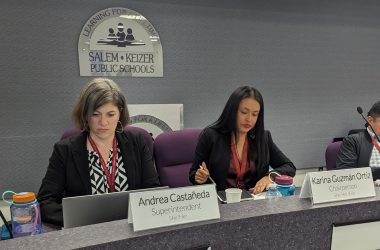
A student at a North Salem High School graduation ceremony on Thursday, August 6, 2020 (Amanda Loman/Salem Reporter)
More than 1,000 students in Salem who began high school last year aren’t on track to graduate on time, a marked increase from the pace before the pandemic.
The Oregon Department of Education released a report Thursday that shows just seven in 10 freshmen in the Salem-Keizer School District were on track, down from 85% in the 2018-19 school year.
The drop in graduation readiness occurred at every high school in Salem and Keizer and for nearly every demographic group. It was even more substantial for students who have historically posted lower graduation rates than average. This included homeless students, Pacific Islanders, non-native English speakers and Latinos.
“I’m concerned … I’m also confident that we can get kids caught back up,” said Larry Ramirez, district director of high schools.
The state data offers one of the first comprehensive looks at how a year of school conducted mostly online affected students in Salem and across Oregon.
Oregon has yet to release data on high school graduation rates for 2021, but Salem high schools last year recorded a substantial increase in the number of students failing classes, mirroring a national trend.
The state data measures how many students complete at least six credits during their first year of high school – a fourth of what they will need to graduate.
That measure can serve as an early precursor to graduation rates, but it’s also something high school educators track closely and use to find students struggling.
Ramirez said across local high schools struggled to engage some students during online school.
He said the uneven impacts of the pandemic likely account for why some groups of freshmen struggled more than others.
Latino, Pacific Islander and Black Oregonians recorded higher rates of Covid infection than white Oregonians, and Ramirez said many high school students of color in the district took on jobs to support their family while schools were online.
For those still learning English in high school, going online often proved an additional challenge.
“There’s still that digital gap that we’re trying to close. It’s a variety of factors, just the engagement, being able to make that connection,” he said.
(Graphic by Rachel Alexander/Salem Reporter)
The Salem district made substantial gains in high school graduation rates over the past five years, and also made progress toward closing gaps along racial and ethnic lines.
Black and Pacific Islander students in particular posted large increases, but their graduation rates, as well as those for Latino and Native American students, remain below their white and Asian peers.
Gains in graduation rates are at risk if schools can’t reverse gaps that widened during the pandemic.
State data says just 39% of the district’s 88 Pacific Islander freshmen were on track to graduate after last year, down from 68% in 2019. That’s both the lowest share of students on track and the largest backslide during the pandemic.
Latino students, the largest ethnic group in the district, went from 83% on track in 2019 to 61%.
White students, the second-largest group, went from 87% on track to 80%.
Black freshmen were the only racial group that showed improvement during the pandemic, going from 73% of freshmen on track in 2019 to 82% in 2021.
About 1% of district students are Black, which means data tends to fluctuate more year-over-year than for larger student groups. In 2018, 85% of Black freshmen were on track to graduate. Last year’s freshman class included 45 Black students, state data shows.
Schools now face the daunting task of engaging kids who may have missed online classes and helping them catch up on credits needed to graduate on time.
Erik Jespersen, principal of McNary High School, said he’s confident educators can do that.
In August, the school’s staff made 565 home visits, he said, connecting personally with each incoming freshmen “so that if things go sideways with grades or whatever, they remember that, you know what, we actually do care, and it’s not just us saying we care, but you were on my front porch a couple weeks ago.”
He expects some gains will come from the school’s ability to identify struggling students and help them pass classes or make up those they failed. Those efforts were harder with school online, but he said it’s easier now for teachers to check in with struggling students when they see them daily at school.
Each student gets assigned a teacher who will act as an adviser the student’s four years at McNary. Those advisers get regular updates about students’ progress toward graduation so they can check in with those falling behind.
Freshman year is especially important, educators say.
“That’s what sets the tone for kids. That’s where you get a lot of self-fulling prophecies with kids, where they’re feeling like they can be successful or not successful,” he said.
High schools are also using millions of dollars in federal Covid relief intended to help students catch up.
Ramirez said each high school has extra money to pay staff for additional before or after school time with students. The district also allocated about $900,000 to hire nine high school math or science teachers.
That is intended to reduce class sizes to help students who struggle with algebra I, a math course typically taken freshman year that often proves a hurdle for keeping students on track to graduate, Ramirez said.
Schools also received money to hire more mentors for students. Ramirez said high school administrators and principals are meeting regularly to track where their students are.
“It’s one thing to be behind. The next step is to become discouraged and unengaged, that’s what we’ve got to stop,” Ramirez said. “How do we give kids the confidence or some wins so they continue through the process of graduating high school? What we can’t have is ‘I feel so overwhelmed’ or so defeated that I throw in the towel.”
Contact reporter Rachel Alexander: [email protected] or 503-575-1241.
JUST THE FACTS, FOR SALEM – We report on your community with care and depth, fairness and accuracy. Get local news that matters to you. Subscribe to Salem Reporter starting at $5 a month. Click I want to subscribe!

Rachel Alexander is Salem Reporter’s managing editor. She joined Salem Reporter when it was founded in 2018 and covers city news, education, nonprofits and a little bit of everything else. She’s been a journalist in Oregon and Washington for a decade. Outside of work, she’s a skater and board member with Salem’s Cherry City Roller Derby and can often be found with her nose buried in a book.









